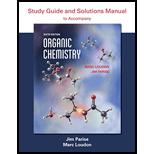
(a)
Interpretation:
The equilibrium constant for the reaction at
Concept introduction:
The change in standard free energy is given by an expression shown below.
Where,
•
•
•
•
•
(b)
Interpretation:
The standard free-energy difference between starting materials and products for a reaction that has an equilibrium constant of
Concept introduction:
The change in standard free energy is given by an expression shown below.
Where,
•
•
•
•
•
Want to see the full answer?
Check out a sample textbook solution
Chapter 3 Solutions
Organic Chemistry Study Guide and Solutions
- Actually, the carbon in CO2(g) is thermodynamically unstable with respect to the carbon in calcium carbonate(limestone). Verify this by determining the standardGibbs free energy change for the reaction of lime,CaO(s), with CO2(g) to make CaCO3(s).arrow_forwardAnother step in the metabolism of glucose, which occurs after the formation of glucose6-phosphate, is the conversion of fructose6-phosphate to fructose1,6-bisphosphate(bis meanstwo): Fructose6-phosphate(aq) + H2PO4(aq) fructose l,6-bisphosphate(aq) + H2O() + H+(aq) (a) This reaction has a Gibbs free energy change of +16.7 kJ/mol of fructose6-phosphate. Is it endergonic or exergonic? (b) Write the equation for the formation of 1 mol ADP fromATR for which rG = 30.5 kJ/mol. (c) Couple these two reactions to get an exergonic process;write its overall chemical equation, and calculate theGibbs free energy change.arrow_forwardDetermine the standard Gibbs free energy change, rG, for the reactions of liquid methanol, of CO(g), and ofethyne, C2H2(g), with oxygen gas to form gaseous carbondioxide and (if hydrogen is present) liquid water at298 K. Use your calculations to decide which of thesesubstances are kinetically stable and which are thermodynamically stable: CH3OH(), CO(g), C2H9(g), CO2(g),H2O().arrow_forward
- a Calculate K1, at 25C for phosphoric acid: H3PO4(aq)H+(aq)+H2PO4(aq) b Which thermodynamic factor is the most significant in accounting for the fact that phosphoric acid is a weak acid? Why ?arrow_forwardDetermine the equilibrium constant for the reaction Sn+Pb2+Sn2++Pbarrow_forwardThe ionization constant, Ka, for acetic acid is 1.8 105 at 25 C. What is the value of rG for this reaction? Is this reaction product- or reactant-favored at equilibrium?arrow_forward
- 5.11. Determine the numerical value of Q for the reaction conditions indicated.arrow_forwardThe equilibrium constant for a certain reaction increases by a factor of 6.67 when the temperature is increased from 300.0 K to 350.0 K. Calculate the standard change in enthalpy (H) for this reaction (assuming H is temperature-independent).arrow_forwardDescribe a nonchemical system that is not in equilibrium, and explain why equilibrium has not been achieved.arrow_forward
 Chemistry: Principles and PracticeChemistryISBN:9780534420123Author:Daniel L. Reger, Scott R. Goode, David W. Ball, Edward MercerPublisher:Cengage Learning
Chemistry: Principles and PracticeChemistryISBN:9780534420123Author:Daniel L. Reger, Scott R. Goode, David W. Ball, Edward MercerPublisher:Cengage Learning Chemistry: The Molecular ScienceChemistryISBN:9781285199047Author:John W. Moore, Conrad L. StanitskiPublisher:Cengage Learning
Chemistry: The Molecular ScienceChemistryISBN:9781285199047Author:John W. Moore, Conrad L. StanitskiPublisher:Cengage Learning Principles of Modern ChemistryChemistryISBN:9781305079113Author:David W. Oxtoby, H. Pat Gillis, Laurie J. ButlerPublisher:Cengage Learning
Principles of Modern ChemistryChemistryISBN:9781305079113Author:David W. Oxtoby, H. Pat Gillis, Laurie J. ButlerPublisher:Cengage Learning Chemistry & Chemical ReactivityChemistryISBN:9781337399074Author:John C. Kotz, Paul M. Treichel, John Townsend, David TreichelPublisher:Cengage Learning
Chemistry & Chemical ReactivityChemistryISBN:9781337399074Author:John C. Kotz, Paul M. Treichel, John Townsend, David TreichelPublisher:Cengage Learning ChemistryChemistryISBN:9781305957404Author:Steven S. Zumdahl, Susan A. Zumdahl, Donald J. DeCostePublisher:Cengage Learning
ChemistryChemistryISBN:9781305957404Author:Steven S. Zumdahl, Susan A. Zumdahl, Donald J. DeCostePublisher:Cengage Learning





